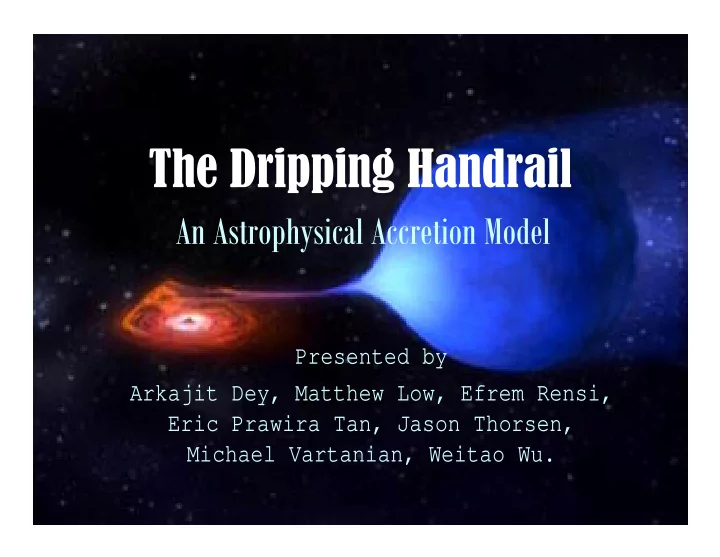

Presented by Arkajit Dey , Matthew Low, Efrem Rensi , Eric Prawira Tan, Jason Thorsen , Michael Vartanian , Weitao Wu.
• Introduction • Transient Chaos • Simulation and Animation • Return Map I • Return Map II • Modified DHR Model • Fixed Points • Recap • Acknowledgement
Artist’s View of Neutron Star (L) Accreting Matter From Companion Star (R)
Under such extreme conditions, standard models break down, so ...
• Constant accretion into cells • Diffusion from neighbors • Cell “drips” when full • Result: chaos
Original Model with Recent Observations
• Miller & Lamb “Effect of Radiation Forces on Accretion” • Outward radiation force causes time-varying accretion • Radiation drag force causes asymmetric diffusion
Extended Model with Recent Observations
• Original model accounts for chaos and low-frequency oscillations in recent observations • Our extended model may help explain high-frequency oscillations as well
• Scargle & Young: original model displays chaos only for limited (“transient”) times • How does the power spectrum of our extended model evolve over long periods?
Non-chaotic Chaotic initial Periodic spectrum spectrum at t = 1 at t = 50
Chaotic spectrum Unchanged with high-frequency spectrum at t = 50 oscillations at t = 1
• “Transient Chaos” in the original model : Significant change in the power spectrum over a period of time • “Permanent Chaos” in the extended model: The power spectrum stays the same indefinitely - advantage
Inner edge of disk represented as cells, Each cell having a state. “Density”
• Cells accrete mass (state values increse) • Diffusion occurs between cells • Cell density resets at a threshold value
• “Return map” is a misnomer. • Compare mass at a particular time x n to the mass at a future time x n+k – x n vs. x n+k • Return map I: – Random initial conditions – n and k both fixed • Return map II: – Same initial condition – n varies, k fixed.
• Mass at a certain time vs. one time step later • We don’t expect much change
• Variability increases as time moves forward
• Bands form in the lower-right-hand corner • Mass appears to “discretize”
• Higher accretion rate • Pattern repeats itself once
• Where the dots are more concentrated, the cell’s mass is more likely to be “located” in that area. • After enough time, the mass in a cell becomes “discretized”, i.e., can only take on one of finitely many values • It would be interesting to examine raw astronomical data to confirm these observations.
• Single cell’s mass at time n vs. at time n+ 5 • Going through cycles with small shifts
• Total mass of the cells at time n vs. at time n+ 1. • Showing fractals
• Adding onto Young & Scargle’s DHR model, we have the following discrete dynamical system. The time variable is discrete. X f X ( ) – n 1 n f H : H – N N – f X ( ) AX b • In the extended model we added a constant > 0 to model dynamic accretion. Then the modified matrix, A, is as shown above.
• Each vector X has n coordinates all with values between 0 and 1 (i.e. ) that X H N is the density of the corresponding cell. • One of the first ways to investigate a dynamical system is by finding eigenvalues. Adding the constant makes X H N the modified eigenvalues . This i i guarantees that at least one eigenvalue is greater than 1 contributing to permanent chaos. • The modified matrix has the same eigenvectors as the original matrix does.
• A fixed point will satisfy: • The solution is: If m is an integer and every component has value between 0 and 1. If there is no time- varying accretion, fixed points do not exist.
• Our extended model shows promise of explaining recent observations • Our visualization and return map studies give valuable new ways of extracting info • Our abstract study has given a deeper understanding of the underlying dynamics
Dr. J. Scargle (NASA) Dr. S. Simi c (SJSU Math) The Woodward Fund
Recommend
More recommend